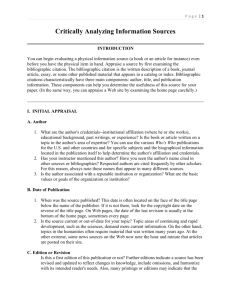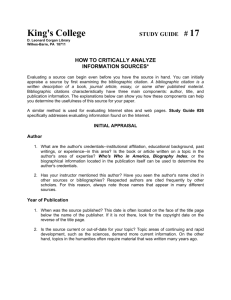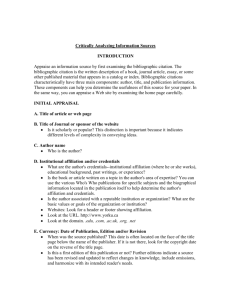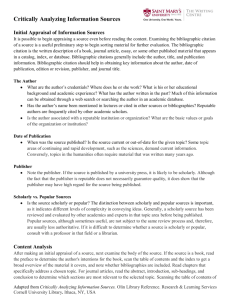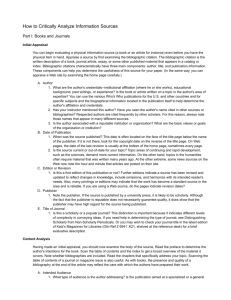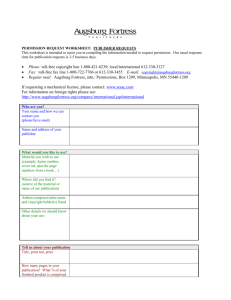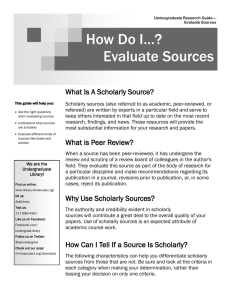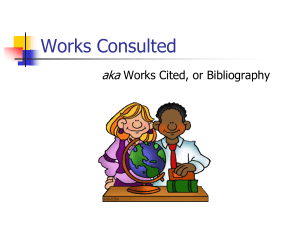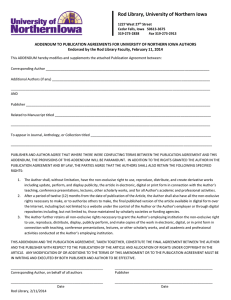Critically Analyzing Information Sources
advertisement
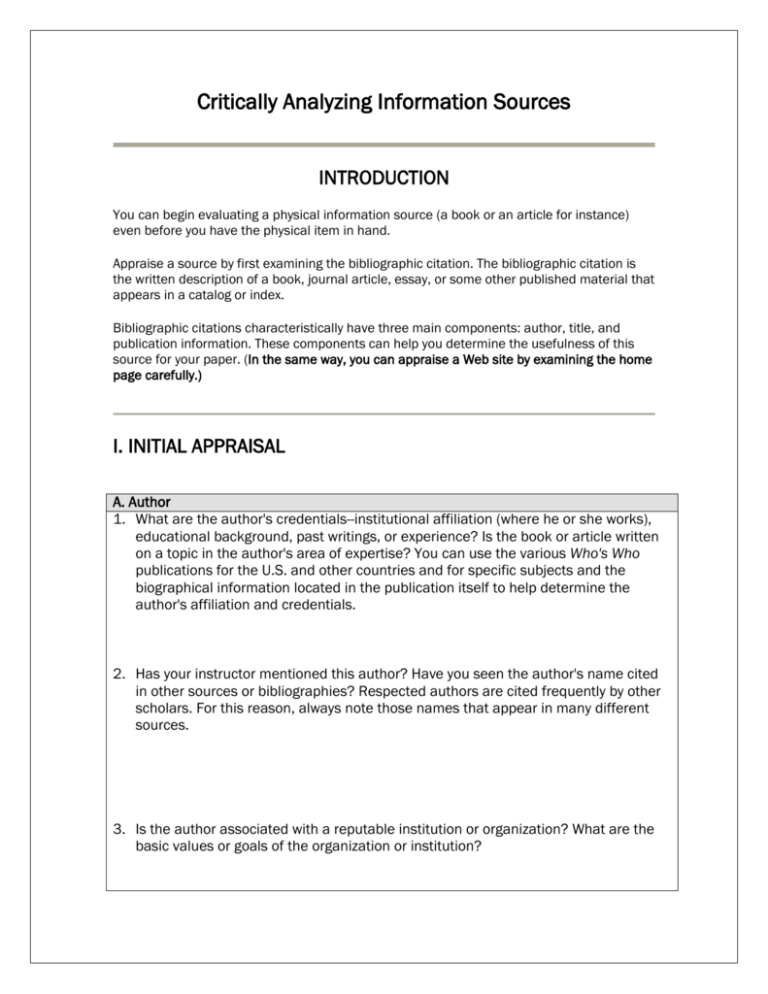
Critically Analyzing Information Sources INTRODUCTION You can begin evaluating a physical information source (a book or an article for instance) even before you have the physical item in hand. Appraise a source by first examining the bibliographic citation. The bibliographic citation is the written description of a book, journal article, essay, or some other published material that appears in a catalog or index. Bibliographic citations characteristically have three main components: author, title, and publication information. These components can help you determine the usefulness of this source for your paper. (In the same way, you can appraise a Web site by examining the home page carefully.) I. INITIAL APPRAISAL A. Author 1. What are the author's credentials--institutional affiliation (where he or she works), educational background, past writings, or experience? Is the book or article written on a topic in the author's area of expertise? You can use the various Who's Who publications for the U.S. and other countries and for specific subjects and the biographical information located in the publication itself to help determine the author's affiliation and credentials. 2. Has your instructor mentioned this author? Have you seen the author's name cited in other sources or bibliographies? Respected authors are cited frequently by other scholars. For this reason, always note those names that appear in many different sources. 3. Is the author associated with a reputable institution or organization? What are the basic values or goals of the organization or institution? B. Date of Publication 1. When was the source published? This date is often located on the face of the title page below the name of the publisher. If it is not there, look for the copyright date on the reverse of the title page. On Web pages, the date of the last revision is usually at the bottom of the home page, sometimes every page. 2. Is the source current or out-of-date for your topic? Topic areas of continuing and rapid development, such as the sciences, demand more current information. On the other hand, topics in the humanities often require material that was written many years ago. At the other extreme, some news sources on the Web now note the hour and minute that articles are posted on their site. C. Edition or Revision Is this a first edition of this publication or not? Further editions indicate a source has been revised and updated to reflect changes in knowledge, include omissions, and harmonize with its intended reader's needs. Also, many printings or editions may indicate that the work has become a standard source in the area and is reliable. If you are using a Web source, do the pages indicate revision dates? D. Publisher Note the publisher. If the source is published by a university press, it is likely to be scholarly. Although the fact that the publisher is reputable does not necessarily guarantee quality, it does show that the publisher may have high regard for the source being published. E. Title of Journal Is this a scholarly or a popular journal? This distinction is important because it indicates different levels of complexity in conveying ideas. If you need help in determining the type of journal, see Distinguishing Scholarly from Non-Scholarly Periodicals. Or you may wish to check your journal title in the latest edition of Katz's Magazines for Libraries. . II. CONTENT ANALYSIS Having made an initial appraisal, you should now examine the body of the source. Read the preface to determine the author's intentions for the book. Scan the table of contents and the index to get a broad overview of the material it covers. Note whether bibliographies are included. Read the chapters that specifically address your topic. Scanning the table of contents of a journal or magazine issue is also useful. As with books, the presence and quality of a bibliography at the end of the article may reflect the care with which the authors have prepared their work. A. Intended Audience What type of audience is the author addressing? Is the publication aimed at a specialized or a general audience? Is this source too elementary, too technical, too advanced, or just right for your needs? B. Objective Reasoning 1. Is the information covered fact, opinion, or propaganda? It is not always easy to separate fact from opinion. Facts can usually be verified; opinions, though they may be based on factual information, evolve from the interpretation of facts. Skilled writers can make you think their interpretations are facts. 2. Does the information appear to be valid and well-researched, or is it questionable and unsupported by evidence? Assumptions should be reasonable. Note errors or omissions. 3. Are the ideas and arguments advanced more or less in line with other works you have read on the same topic? The more radically an author departs from the views of others in the same field, the more carefully and critically you should scrutinize his or her ideas. 4. Is the author's point of view objective and impartial? Is the language free of emotion-arousing words and bias? C. Coverage 1. Does the work update other sources, substantiate other materials you have read, or add new information? Does it extensively or marginally cover your topic? You should explore enough sources to obtain a variety of viewpoints. 2. Is the material primary or secondary in nature? Primary sources are the raw material of the research process. Secondary sources are based on primary sources. For example, if you were researching Konrad Adenauer's (First Chancellor in West Germany, 1949-63) role in rebuilding West Germany after World War II, Adenauer's own writings would be one of many primary sources available on this topic. Others might include relevant government documents and contemporary German newspaper articles. Scholars use this primary material to help generate historical interpretations--a secondary source. Books, encyclopedia articles, and scholarly journal articles about Adenauer's role are considered secondary sources. In the sciences, journal articles and conference proceedings written by experimenters reporting the results of their research are primary documents. Choose both primary and secondary sources when you have the opportunity. D. Writing Style Is the publication organized logically? Are the main points clearly presented? Do you find the text easy to read, or is it stilted or choppy? Is the author's argument repetitive? E. Evaluative Reviews 1. Locate critical reviews of books in a reviewing source, such as Book Review Index, Book Review Digest, OR Periodical Abstracts. Is the review positive? Is the book under review considered a valuable contribution to the field? Does the reviewer mention other books that might be better? If so, locate these sources for more information on your topic. 2. Do the various reviewers agree on the value or attributes of the book or has it aroused controversy among the critics? 3. For Web sites, consider consulting one of the evaluation and reviewing sources on the Internet or use the handout given to you today. Permission Granted to adapt and use this sheet from the Reference Department Collections, Reference, Instruction & Outreach (CRIO) Cornell University Library Ithaca, NY, USA http://www.library.cornell.edu/olinuris/ref/research/skill26.htm LANGUAGE FOR TALKING ABOUT TEXTS AND ARGUMENTS It is sometimes challenging to find the vocabulary in which to summarize and discuss a text. Here is a list of some verbs for referring to texts and ideas that you might find useful: account for analyze argue assess assert assume claim clarify compare conclude criticize defend define describe depict determine distinguish evaluate emphasize demonstrate examine exemplify exhibit explain frame identify illustrate imply indicate investigate judge justify narrate persuade propose question recognize reflect refer to report review suggest The evidence indicates that . . . The article assesses the effect of . . . The author identifies three reasons for . . . The article questions the view that . . .
